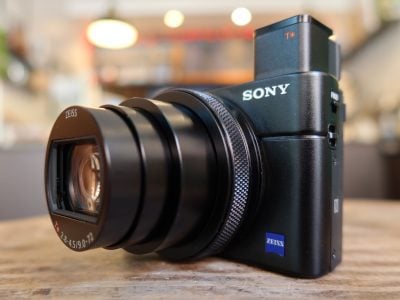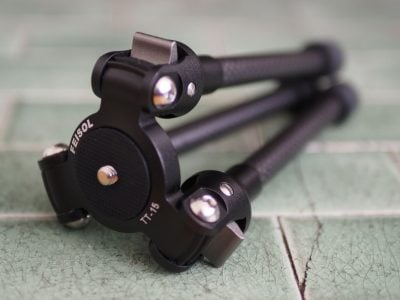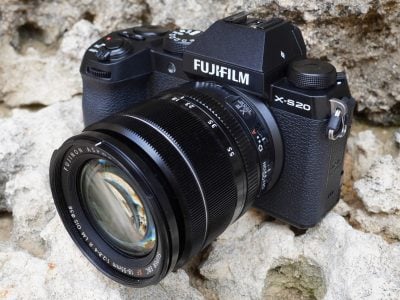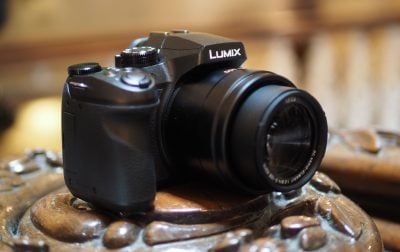Panasonic Lumix FZ330 / FZ300 review
-
-
Written by Ken McMahon
Quality
Panasonic Lumix FZ330 / FZ300 vs Sony RX10 II quality results
To compare real-life performance, I shot this scene with the Panasonic Lumix FZ330 / FZ300 and the Sony Cyber-shot RX10 II within a few moments of each other, using their best quality JPEG settings and at their base sensitivity settings. For this test the cameras were mounted on a tripod and image stabilisation was disabled, the ISO sensitivity was manually set to the lowest available setting and Aperture priority mode was selected for the exposure.
I’d previously determined that Lumix FZ330 / FZ300 produced best results with the lens wide open at f2.8. at which it set the shutter speed to 1/500 at its base 100 ISO sensitivity setting. With its bigger sensor, Sony RX10 II produces its best results with the lens stopped down to f4 where it selected a shutter speed of 1/320 at 100 ISO.
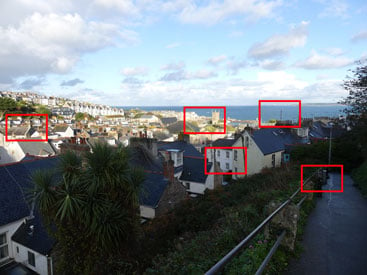
Before we compare the quality of the crops let’s just remind ourselves that the Lumix FZ330 / FZ300’s 12 Megapixel sensor has fewer photosites than the 20 Megapixel sensor in the RX10 II so the latter’s crops show a smaller area with larger detail. The Sony’s sensor is also physically larger at 1 inch compared with the 1/2.3 in sensor of the FZ330 / FZ300. Finally there’s a difference in the aspect ratio, the Sony sensor has 3:2 proportions while the FZ330 / FZ300’s is 4:3.
So, what about the crops? The lighting conditions proved quite demanding, with both models stuggling to maintain highlight detail in the sunlit scene. The first crop from the Lumix FZ330 / FZ300 looks a little bit soft, but that’s to be expected in a crop from the extreme edge of the frame with the lens aperture wide open. The next two crops are from close to middle of the frame, the second one still looks quite soft to me but the third one shows some improvement with sharper edge detail.
The softness is still in evidence in the fourth crop from mid way between the middle and edge of the frame. The lighthouse is indistinct and the small island it sits on also looks a bit blurry as does the foreground detail in this crop. Finally the fifth crop from foreground in shadow looks no sharper than the others and a little noisy. So with the exception of the third crop there’s one word that could be used to describe the performance at this focal length and that’s soft.
With the exception of the first crop which looks even softer than the one from the FZ330 / FZ300, the crops from the Sony RX10 II are much cleaner and crisper. In the second crop there’s more detail just about everywhere, but particularly in the church tower and the tiled roofs in the foreground. The window frames and the wires in front of them are much cleaner in the third crop and the lighthouse and its island are a little more distinct in the fourth one
Overall then a much better performance from the Larger sensor of the Sony RX10 II at this focal length. You can scroll down to see how these models compare at the middle of their zoom ranges and when fully zoomed in or to find out how they compare at higher sensitivities head for my Panasonic Lumix FZ330 / FZ300 noise results, skip to my Panasonic Lumix FZ330 / FZ300 sample images, or head straight to my verdict.

Above left: Panasonic Lumix FZ330 / FZ300 at 4.5mm (25mm equivalent) f2.8, 100 ISO. Above right: Sony RX10 II at 8.8mm (24mm equivalent) f4, 100 ISO

Above left: Panasonic Lumix FZ330 / FZ300 at 4.5mm (25mm equivalent) f2.8, 100 ISO. Above right: Sony RX10 II at 8.8mm (24mm equivalent) f4, 100 ISO

Above left: Panasonic Lumix FZ330 / FZ300 at 4.5mm (25mm equivalent) f2.8, 100 ISO. Above right: Sony RX10 II at 8.8mm (24mm equivalent) f4, 100 ISO

Above left: Panasonic Lumix FZ330 / FZ300 at 4.5mm (25mm equivalent) f2.8, 100 ISO. Above right: Sony RX10 II at 8.8mm (24mm equivalent) f4, 100 ISO

Above left: Panasonic Lumix FZ330 / FZ300 at 4.5mm (25mm equivalent) f2.8, 100 ISO. Above right: Sony RX10 II at 8.8mm (24mm equivalent) f4, 100 ISO
Panasonic Lumix FZ330 / FZ300 vs Sony RX10 II quality at 50mm equivalent
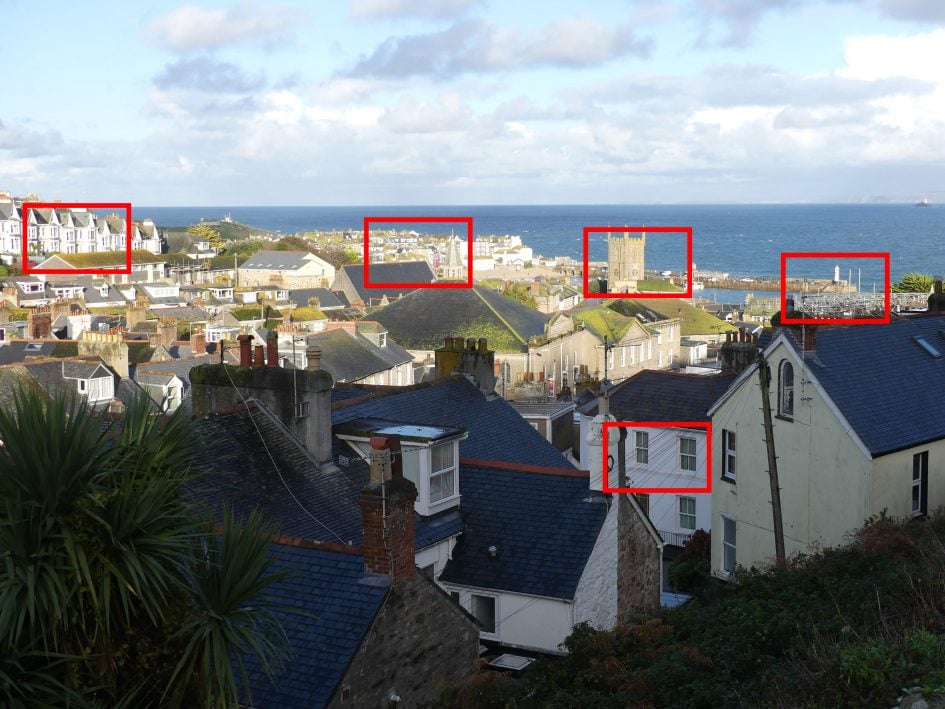
The image above was taken with the Lumix FZ330 / FZ300. As before the camera was mounted on a tripod and stabilisation disabled. The crops are taken from the areas marked in red.
Zoomed in to the 50mm ‘standard’ focal length, the Lumix FZ330 / FZ300 gets off to a much better start than at its wide angle setting. The first crop from close to the left edge of the frame has little of the softness of the wide angle crop, the edges are crisp and there’s a good level of detail. The only thing that detracts from the quality here is the merest hint of colour fringing. Moving on to the crops from the middle of the frame, these too are a lot sharper. You can tell the time from the church clock, there’s plenty of detail in the stonework. The good news continues into the fourth crop with those pin sharp cables in front of the crisp white window frames of the bulding backdrop. It gets a tiny bit softer in the final crop from close to the right edge of the frame and, as on the first crop, there’s visible colour fringing, but overall this is a very good result for the FZ330 / FZ300.
By comparison the first crop from the RX10 II is very soft and though things improve in the central crops overall this set of results from the RX10 II isn’t as sharp or as detailed as those from the FZ330 / FZ300.

Above left: Panasonic Lumix FZ330 / FZ300 at 9.1mm (50mm equivalent) f2.8, 100 ISO. Above right: Sony RX10 II at 18.2mm (50mm equivalent) f4, 100 ISO.

Above left: Panasonic Lumix FZ330 / FZ300 at 9.1mm (50mm equivalent) f2.8, 100 ISO. Above right: Sony RX10 II at 18.2mm (50mm equivalent) f4, 100 ISO.

Above left: Panasonic Lumix FZ330 / FZ300 at 9.1mm (50mm equivalent) f2.8, 100 ISO. Above right: Sony RX10 II at 18.2mm (50mm equivalent) f4, 100 ISO.

Above left: Panasonic Lumix FZ330 / FZ300 at 9.1mm (50mm equivalent) f2.8, 100 ISO. Above right: Sony RX10 II at 18.2mm (50mm equivalent) f4, 100 ISO.

Above left: Panasonic Lumix FZ330 / FZ300 at 9.1mm (50mm equivalent) f2.8, 100 ISO. Above right: Sony RX10 II at 18.2mm (50mm equivalent) f4, 100 ISO.
Panasonic Lumix FZ330 / FZ300 vs Sony RX10 II quality at 100mm equivalent
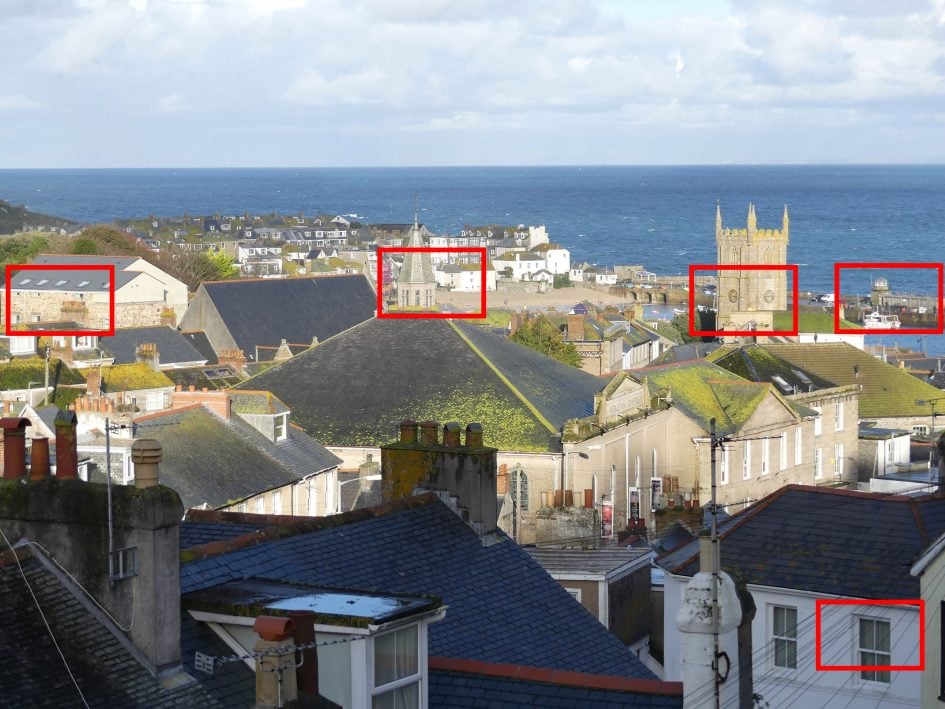
For this next set of crops I zoomed both cameras in to 100mm equivalent – exactly half way through the Sony RX10 II’s range, but only a sixth of the way through the FZ330 / FZ300’s. At its wide angle setting the FZ330 / FZ300 crops were uniformly soft, at 50mm they were sharp, here at 100mm we’ve got a bit of both. The first crop from close to the left edge is a little soft, though it’s not too bad. Things are looking sharper in the second and third crops, but the fourth crop, from the extreme right edge looks quite blurry. The cables in the final crop from the bottom right corner of the frame aren’t as crisp as in the previous result and once again there’s a little bit of colour fringing.
Interestingly, this time around the Sony RX10 II crops closely match those from the Lumix FZ330 / FZ300. They’re soft, even blurry at the edges, sharper, but by no means outstandingly crisp and detailed in the middle.

Above left: Panasonic Lumix FZ330 / FZ300 at 17.8mm (99mm equivalent) f2.8, 100 ISO. Above right: Sony RX10 II at 36.7mm (100mm equivalent) f4, 100 ISO

Above left: Panasonic Lumix FZ330 / FZ300 at 17.8mm (99mm equivalent) f2.8, 100 ISO. Above right: Sony RX10 II at 36.7mm (100mm equivalent) f4, 100 ISO

Above left: Panasonic Lumix FZ330 / FZ300 at 17.8mm (99mm equivalent) f2.8, 100 ISO. Above right: Sony RX10 II at 36.7mm (100mm equivalent) f4, 100 ISO

Above left: Panasonic Lumix FZ330 / FZ300 at 17.8mm (99mm equivalent) f2.8, 100 ISO. Above right: Sony RX10 II at 36.7mm (100mm equivalent) f4, 100 ISO

Above left: Panasonic Lumix FZ330 / FZ300 at 17.8mm (99mm equivalent) f2.8, 100 ISO. Above right: Sony RX10 II at 36.7mm (100mm equivalent) f4, 100 ISO
Panasonic Lumix FZ330 / FZ300 vs Sony RX10 II quality at 200mm equivalent
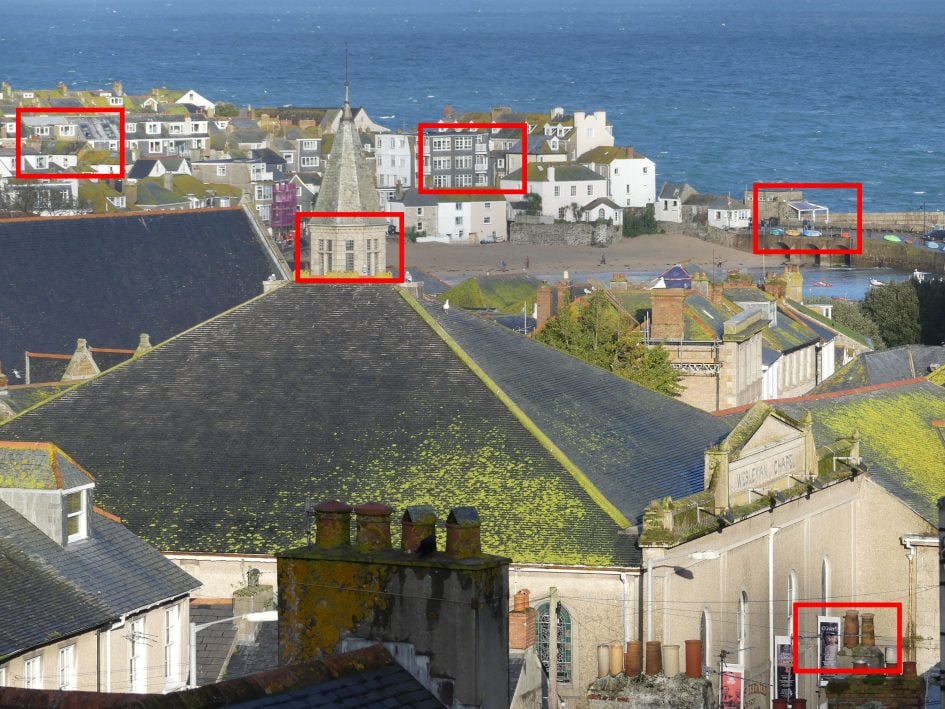
For this final comparison, I zoomed both cameras in to 200mm equivalent – the maximum on the Sony RX10 II. And at this focal length the FZ330 / FZ200 results gain some consistency, with slightly soft results across the frame. But though they’re not pin sharp, there’s still a good level of detail in these crops and you could probably improve things a little in terms of sharpness with a custom photo style. The detail in the Sony RX10 II crops is bigger, but I think there’s more of it and, with the exception of the final crop the RX10 II results are also a little sharper.

Above left: Panasonic Lumix FZ330 / FZ300 at 36.1mm (200mm equivalent) f2.8, 100 ISO. Above right: Sony RX10 II at 73.3mm (200mm equivalent) f4, 100 ISO

Above left: Panasonic Lumix FZ330 / FZ300 at 36.1mm (200mm equivalent) f2.8, 100 ISO. Above right: Sony RX10 II at 73.3mm (200mm equivalent) f4, 100 ISO

Above left: Panasonic Lumix FZ330 / FZ300 at 36.1mm (200mm equivalent) f2.8, 100 ISO. Above right: Sony RX10 II at 73.3mm (200mm equivalent) f4, 100 ISO

Above left: Panasonic Lumix FZ330 / FZ300 at 36.1mm (200mm equivalent) f2.8, 100 ISO. Above right: Sony RX10 II at 73.3mm (200mm equivalent) f4, 100 ISO

Above left: Panasonic Lumix FZ330 / FZ300 at 36.1mm (200mm equivalent) f2.8, 100 ISO. Above right: Sony RX10 II at 73.3mm (200mm equivalent) f4, 100 ISO
Panasonic Lumix FZ330 / FZ300 at 600mm equivalent
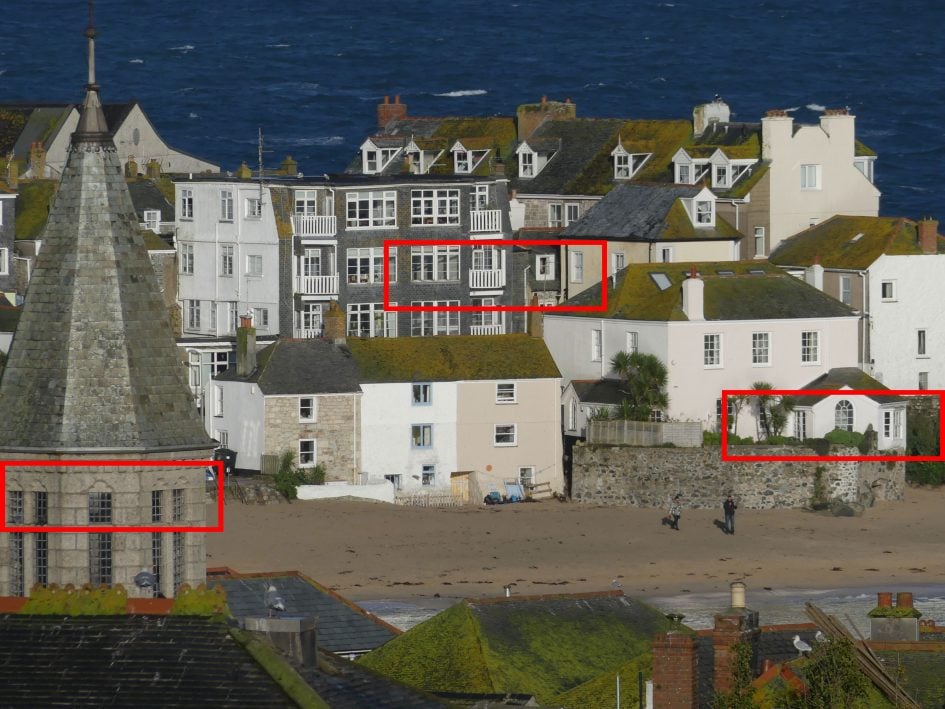
Lastly, here’s a set of crops from the Lumix FZ330 / FZ300 at its maximum 600mm equivalent focal length. For this shot I had to close the aperture to f4 to get the correct exposure. These crops are more or less consistent with what we saw from the Lumix FZ330 / FZ300 in the middle of its zoom range with a slight softness that’s a little more pronounced at the edges of the frame.

Above: Panasonic Lumix FZ330 / FZ300 at 108mm (600mm equivalent) f4, 100 ISO

Above: Panasonic Lumix FZ330 / FZ300 at 108mm (600mm equivalent) f4, 100 ISO

Above: Panasonic Lumix FZ330 / FZ300 at 108mm (600mm equivalent) f4, 100 ISO
Panasonic Lumix FZ330 / FZ300 vs Sony RX10 II noise results
To compare noise levels under real-life conditions, I shot this scene with the Panasonic Lumix FZ330 / FZ300 and the Sony Cyber-shot RX10 II within a few moments of each other at each of their ISO settings. All three cameras were set to their RAW +JPEG modes and mounted on a tripod and stabilisation was disabled.
The cameras were set to their maximum wide angle view – 24mm equivalent on the RX10 II and 25mm equivalent on the FZ330 / FZ300 – which provided the same vertical angle of view. The ISO sensitivity was manually set to the lowest available setting and Aperture priority mode was selected for the exposure.
I’d previously determined that f2.8 produced the best results from the FZ330 / FZ300’s lens and f4 was the optimum apeture on the RX10 II. So with the aperture set to f2.8 and the sensitivity set to 100 ISO, the the FZ330 / FZ300 metered an exposure of 1/4s. Set to f4, the RX10 II, also at 100 ISO metered 0.6s
Once again, a reminder that the Lumix FZ330 / FZ300’s 12 Megapixel sensor has fewer photosites than the 20 Megapixel sensor in the RX10 II so the latter’s crops show a smaller area with larger detail. The Sony’s sensor is also physically larger at 1 inch compared with the 1/2.3 in sensor of the FZ330 / FZ300. Finally there’s a difference in the aspect ratio, the Sony sensor has 3:2 proportions while the FZ330 / FZ300’s is 4:3. One other thing to note is that the Sony RX10 II has an extended ISO range that provides 64 and 80 ISO settings. I haven’t included those here but have done in my RX10 II review.
The first 100 ISO crop from the Lumix FZ330 / FZ300 is far from noise free. There’s a grainy texture clearly visible on the hymn board on the right side of the crop and it’s already affecting the text on the white label at the top as well as the numbers.
But while the 100 ISO crop isn’t squeaky clean the noise doesn’t increase dramatically stepping up to 200 ISO. In fact each step up the sensitivity scale from 100 to 800 ISO brings with it a fairly small linear increase in the amount of noise. Overall this is a good performance for a 1/2.3in compact sensor at the lower end of the sensitivity scale.
At 1600 ISO, whether as a consequence of the relatively high base ISO noise, the small accumulations, or a spike in the noise levels at this sensitivity (probably a little of each of those), things are beginning to look a little grungy. Edges are beginning to falter and there’s a clumpiness to medium sized detail. 3200 ISO still produces acceptable results for viewing at smaller sizes and 6400 ISO is a worthwhile setting to rely on for must have shots in near darkness.
It’s hard for the FZ330 / FZ300 to look good in the company of the Sony RX10 II which, though it has a higher pixel count also has a physically much larger sensor resuting in visibly superior noise performance across the sensitivity range. The 100 ISO crop from the RX10 II looks much cleaner and crisper than the one opposite from the FZ330 / FZ300, there isn’t a speck of noise to be seen anywhere.
Like the FZ330 / FZ300, the RX10 II noise increases by a small margin with each step up the sensitivity scale, which with the very low base ISO noise characteristic means great results right up to 1600 ISO. Even at 6400 ISO – the FZ330 / FZ300’s ’emergency use only’ ceiling, the RX10 II crop is looking very good indeed. Plus the Sony offers a 12800 ISO setting and, if you switch to Multi Frame Noise Reduction mode a top setting of 25600 ISO. Incidentally, Multi-frame noise reduction, which shoots a short burst of frames and produces a low noise composite from them, is available right through the sensitivity range from 100 to 25600 ISO.
So it looks like a hands down victory for the Sony RX10 II’s bigger 1 inch sensor. But before we move on, how much of the Sony’s superior noise performance can be attributed to processing? The second table below compares RAW reults from both cameras processed in the same way. All the RAW files were processed in Adobe Camera RAW using the same settings: a high degree of sharpening (50 / 0.5 / 36 / 10) and zero noise reduction. These settings were chosen to reveal the differences in sensor quality and isolate them from in-camera processing. The high degree of sharpening with a small radius enhances the finest details without causing undesirable artefacts, while the zero noise reduction unveils what’s really going on behind the scenes – as such the visible noise levels at higher ISOs will be much greater than you’re used to seeing in many comparisons, but again it’s an approach that’s designed to show the actual detail that’s being recorded before you start work on processing and cleaning it up if desired.
In actual fact, these RAW results don’t reveal anything surprising, but confirm what we saw from the JPEGs. The Sony RX10 II’s sensor is producing much cleaner images with a lot less noise than those from the Lumix FZ3300 / FZ300. The bottom line is if you want clean images at high ISOs, a bigger sensor is always preferable.

Above left: Panasonic Lumix FZ330 / FZ300 JPEG at 100 ISO. Above right: Sony RX10 II JPEG at 100 ISO

Above left: Panasonic Lumix FZ330 / FZ300 JPEG at 200 ISO. Above right: Sony RX10 II JPEG at 200 ISO

Above left: Panasonic Lumix FZ330 / FZ300 JPEG at 400 ISO. Above right: Sony RX10 II JPEG at 400 ISO

Above left: Panasonic Lumix FZ330 / FZ300 JPEG at 800 ISO. Above right: Sony RX10 II JPEG at 800 ISO

Above left: Panasonic Lumix FZ330 / FZ300 JPEG at 1600 ISO. Above right: Sony RX10 II JPEG at 1600 ISO

Above left: Panasonic Lumix FZ330 / FZ300 JPEG at 3200 ISO. Above right: Sony RX10 II JPEG at 3200 ISO

Above left: Panasonic Lumix FZ330 / FZ300 JPEG at 6400 ISO. Above right: Sony RX10 II JPEG at 6400 ISO

Above left: Panasonic Lumix FZ330 / FZ300 JPEG 12800 ISO not available. Above right: Sony RX10 II JPEG at 12800 ISO

Above left: Panasonic Lumix FZ330 / FZ300 JPEG 25600 ISO not available. Above right: Sony RX10 II JPEG at 25600 ISO
Panasonic Lumix FZ330 / FZ300 vs Sony RX10 II RAW noise results

Above left: Panasonic Lumix FZ330 / FZ300 RAW at 100 ISO. Above right: Sony RX10 II RAW at 100 ISO

Above left: Panasonic Lumix FZ330 / FZ300 RAW at 200 ISO. Above right: Sony RX10 II RAW at 200 ISO

Above left: Panasonic Lumix FZ330 / FZ300 RAW at 400 ISO. Above right: Sony RX10 II RAW at 400 ISO

Above left: Panasonic Lumix FZ330 / FZ300 RAW at 800 ISO. Above right: Sony RX10 II RAW at 800 ISO

Above left: Panasonic Lumix FZ330 / FZ300 RAW at 1600 ISO. Above right: Sony RX10 II RAW at 1600 ISO

Above left: Panasonic Lumix FZ330 / FZ300 RAW at 3200 ISO. Above right: Sony RX10 II RAW at 3200 ISO

Above left: Panasonic Lumix FZ330 / FZ300 RAW at 6400 ISO. Above right: Sony RX10 II RAW at 6400 ISO

Above left: Panasonic Lumix FZ330 / FZ300 RAW 12800 ISO not available. Above right: Sony RX10 II RAW at 12800 ISO
